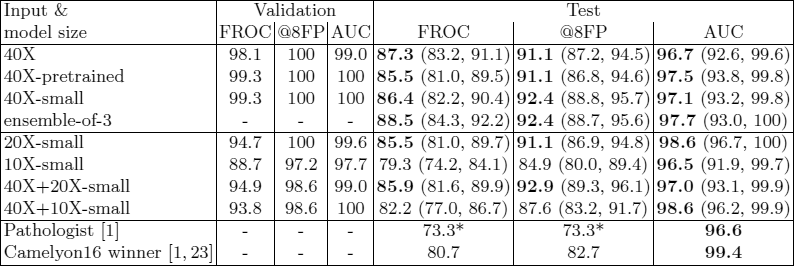Inception neural network saves women's breasts by gigapixel photos

Breast cancer treatment depends heavily on what stage the disease is at. To understand the stage, a microscopic examination of biopsy specimens of adjacent lymph nodes (magnification 40X) is performed. On a certain number of slides of 100,000 × 100,000 pixels, the pathologist carefully searches for areas of cancer cells, that is, metastases. This is a very time-consuming process, accessible only to an experienced specialist. Fortunately, recently, computer vision systems have come to the aid of doctors. A computer is much inferior to a person in terms of specificity, that is, the accuracy of identifying negative samples, but it is ahead of him in sensitivity, that is, the accuracy of identifying positive samples.
The new neural network based on Inception (it is also GoogLeNet: it probably uses elements of the old LeNet neural network, hence the name) noticeably exceeds human sensitivity, not to mention the speed of work. The result of other neural networks on the recognition accuracy of positive samples improved by about ten percentage points or more.
Of course, the computer test will require further confirmation by specialists in order to reduce false positive positives, but now the probability of missing a tumor where it really is is greatly reduced. In other words, diagnosing the stage of breast cancer will become more accurate. This means that the chances of a successful treatment will increase by several percent. This is how machine vision and artificial intelligence save women's breasts - and yet very important organs that no one wants to lose (unlike the appendix, for example, the vermiform process of the rectum).
')
The scientific work presents the Inception (GoogLeNet) based recurrent neural network framework, which searches for cancer metastases in lymph nodes. Researchers managed to halve the number of errors when the number of false positive positives of 8 pieces per slide, compared with other systems of vision.
In the best to date system from the Camelyon16 cancer metastasis competition, the sensitivity index was 75%, assuming 8 false positive positives per slide, and the AUC (that is, the area under the ROC curve ) per slide was 92.5%. The trained neural network has significantly improved these indicators. At eight false positives, the Google neural network shows a sensitivity of about 92%.

* Note: pathologists demonstrate this result, if they are practically not limited in time for studying slides, that is, provide 30 hours for 130 slides for this task
At the same time, pathologists with the result of 73% practically do not allow false positive positives at all. If they say that there is a tumor, then it definitely is.
It should also be understood that the neural network needs preliminary training with the teacher. Thus, its accuracy strongly depends on what specific samples of anomalies it was trained on. At the same time, she does not have the breadth of knowledge of an experienced physician — and is unable to see on the slides any other anomalies such as inflammatory processes, traces of autoimmune diseases, or other types of cancer. It is “sharpened” specifically for a certain appearance of breast cancer cells in the lymph nodes. Therefore, it is also useless in the diagnosis of other types of cancer. Although the authors of the paper say that in some other types of cancer, the neural network based on Inception still can improve recognition accuracy. For example, in recognizing lung cancer.
In general, such neural networks can significantly ease the work of pathologists and reduce the number of false-negative positives. A neural network has four times (!) Fewer false-negative positives than a human pathologist. The number of false-negative positives in more than two times less than that of the best machine vision system developed so far.
Certainly, in the accuracy of image recognition by neural networks in recent years there has been a very rapid progress. This is such a promising and fast-growing area that breakthrough achievements take place here literally every day. The researchers have the main question - which of the applications to choose. Practically in any area where they decide to use a neural network for pattern recognition, a result will be shown that is significantly superior to previous methods.
The authors intend to continue working on their neural network, increasing the data sets for training.
Source: https://habr.com/ru/post/373233/
All Articles